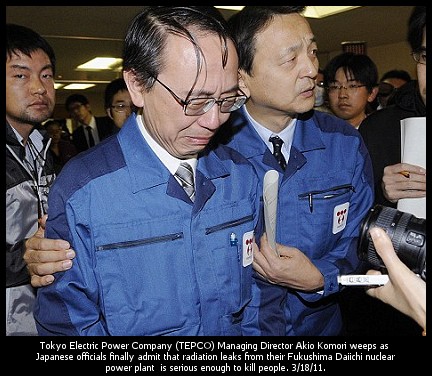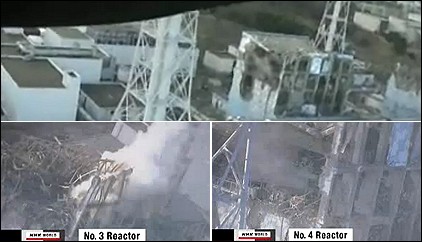
It was precisely one week ago last night at 9:46pm PT (2:46pm in Japan) that the worst earthquake and tsunami on record in that country hit. It was just a few hours later when Tohoku Electric Power Co. officials said that cooling at one of three reactors at their Onagawa nuclear power plant was "not going as planned
That disturbing, yet quietly reported statement certainly caught the attention of The BRAD BLOG, even as it took another 24 to 48 hours before much of the rest of the media began offering appropriate focus on what could still become the most catastrophic nuclear power disaster the world has ever seen. (Though note: CNN still has plenty of resources to spare to deploy 150 staffers --- 150 --- to cover the royal wedding next month in England, so don't worry! Luckily it's likely to be yet another slow news month in April.)
While the Onagawa plant, where a fire had broken out during the quake, was ultimately brought under control and said to be cooling properly, the alarm caused by a rise in radiation levels at that plant turned out to be due to problems at the Tokyo Electric Power Co. (TEPCO) six-reactor nuclear power plant at Daiichi in the neighboring Fukushima prefecture. Now, one week later, TEPCO officials, in a joint effort with the Japanese Govt. --- and finally a number of other international agencies --- are working around the clock to keep all six of the facility's nuclear reactors and/or the associated spent fuel storage pools at each, under control, to avoid complete meltdowns at any or all of them. The work is exceedingly dangerous, and the progress at this hour remains precarious at best.
Some progress is being made in restoring the power plant to the power grid, allowing for the potential restoration of cooling systems at the reactors, if the cooling systems still work at any of them, following earthquake, tsunami flood, multiple explosions, and fires.
So here is where each of those six reactors stands, at this moment (even as a trace amount of radiation is said to have now reached Southern California, where we are located), what the greatest fears still are, how the worst case-scenario still looms, and how Japan's completely undamaged wind farms are currently "saving Japan's ass," even as their nuclear power plants struggle to get back online and/or avoid epic catastrophe...
Japan's Kyodo News offers this summary (Note the disturbing mention, in the Unit 4 description, of a "renewed nuclear chain reaction feared")...
TOKYO, March 19, Kyodo
The following is the known status as of Friday night of each of the six reactors at the Fukushima Daiichi nuclear power plant and the four reactors at the Fukushima Daini plant, both in Fukushima Prefecture, which were crippled by the magnitude 9.0 earthquake and the ensuing tsunami on March 11.
Fukushima Daiichi plant
-- Reactor No. 1 - Operation suspended after quake, cooling failure, partial melting of core, vapor vented, building housing reactor damaged March 12 by hydrogen explosion, roof blown off, seawater being pumped in.
-- Reactor No. 2 - Operation suspended after quake, cooling failure, seawater being pumped in, fuel rods fully exposed temporarily, vapor vented, building housing reactor damaged Monday by blast at reactor No. 3, blast sound heard near suppression chamber of containment vessel on Tuesday, damage to containment structure feared.
-- Reactor No. 3 - Operation suspended after quake, cooling failure, partial melting of core feared, vapor vented, seawater being pumped in, building housing reactor badly damaged Monday by hydrogen explosion, high-level radiation measured nearby on Tuesday, plume of smoke observed Wednesday and presumed to have come from spent-fuel storage pool, seawater dumped over pool by helicopter on Thursday, water sprayed at it from ground on Thursday and Friday.
-- Reactor No. 4 - Under maintenance when quake struck, no fuel rods in reactor core, temperature in spent-fuel storage pool reached 84 C on Monday, fire Tuesday possibly caused by hydrogen explosion at pool holding spent fuel rods, fire observed Wednesday at building housing reactor, pool water level feared receding, renewed nuclear chain reaction feared, only frame remains of reactor building roof.
-- Reactors No. 5, 6 - Under maintenance when quake struck, some fuel rods left in reactor cores, water temperatures in spent-fuel storage pools increased to about 64 C on Thursday.
-- Spent-fuel storage pools - Cooling functions lost at reactors No. 1 to 4, water temperatures or levels unobservable at reactors No. 1 to 4, no immediate threat to water level at common spent fuel pool.
Fukushima Daini plant
-- Reactors No. 1, 2, 4 - Operation suspended after quake, cooling failure, then cold shutdown.
-- Reactor No. 3 - Operation suspended after quake, cold shutdown.
As you can see, the latest temperature readings for the fuel pools in Daiichi's Units 4, 5 & 6 --- the units which had already been off-line for maintenance prior to the earthquake/tsunami --- are approximately 84° C, 64° C, and 64° C respectively, with temperature readings impossible to get from Unit 4, due to high radiations levels, since last Monday.
The International Atomic Energy Agency (IAEA), which, as we've previously observed, has been slow to offer details, and very few of them at that, seems to be upping its game, finally, in its latest updates on the situation, following IAEA Chief Yukiya Amano's emergency meeting last night with Japanese Prime Minister Naoto Kan.
According to the IAEA's report from earlier today, "a typical spent fuel pool temperature is kept below 25° C under normal operating conditions." That's what the temperatures at the Units 4, 5 & 6 pools should be. Each of them, however, according to Yokodo's summary above, as well as IAEA's data, is now said to be far in excess of that temperature, as each has been slowly heating up over the last several days, even as officials have been necessarily prioritizing their focus on cooling Units 1, 2 & 3, where extremely hot reactors had been up and operating until the moment they were automatically shut down when the earthquake struck.
How bad could the situation still get? In a story yesterday covering precisely that, Mother Jones' Kate Sheppard quoted Knoxville News Sentinel's interview with Michael Allen, "who has run nuclear-accident simulations at Sandia National Labs":
That, in turn, would cause a "high-pressure melt injection" into the water-filled concrete cavity below the reactor. Because the concrete would likely be unheated, the reaction created by the sudden injection of the reactor's ultra-hot content would be immense, he said.
"It'll be like somebody dropped a bomb, and there'll be a big cloud of very, very radioactive material above the ground," Allen said, noting that it would contain uranium and plutonium, as well as the fission products.
According to a group of U.S. nuclear experts during a panel discussion at the National Press Club in D.C. today, the current actions of the Japanese government, including the dangerous deployment of helicopter water drops and water cannon trucks on Thursday, suggest they are "desperate" at this point...
Alvarez's claim that there are no good options left for addressing the crisis is evidenced by the risky approach Tokyo has taken to cooling the reactors.
When combined with the high heat at the reactor site, the seawater currently being poured on the facilities could destroy their cooling pumps or even corrode the containment vessels holding the plant's nuclear fuel, increasing the difficulty of containing the radioactive material.
''This is what you call the last-ditch stuff,'' Alvarez said, noting that the severity of the crisis had taken the standard, safer options for responding ''off the table.''
In the short term, Alvarez expects that even these extreme measures will be unable to stop the crisis.
''It doesn't appear at this time that they are working. The accident is likely to unfold over a period of weeks,'' he said.
Last night, MSNBC's Rachel Maddow offered a clear, cogent, humane explanation of the concerns which now focus specifically on the spent fuel rods at Units 4 (where a "renewed nuclear chain reaction [is] feared"), 5 & 6, and even at reactors 1 through 3 where spent fuel is also stored on site in cooling ponds which, unlike rods in the reactors themselves, are unprotected by steel vessels and concrete containment structures. She's worth watching here:
Late today --- early tomorrow, Japan time --- TEPCO officials announced that power has been partially restored from the grid to the crippled power plant. It remains unknown, as Maddow mentioned above in her report from last night, whether or not the cooling systems themselves will still work, even after power is turned back on at Fukushima Daiichi:
Agency spokesman Hidehiko Nishiyama said workers were trying to restore power to the plant's No. 1 and No. 2 reactors Saturday and at the No. 3 and No. 4 reactors by Sunday, Kyodo News says.
If power and cooling systems can be restored, we may be able to avoid these worst-case scenarios. "If not," Reuters reports, "there is an option of last resort under consideration to bury the sprawling 40-year-old plant in sand and concrete to prevent a catastrophic radiation release."
That was the method used to ultimately kill the unprecedented radiation billowing from the crippled Chernobyl reactor back in 1986. Next month will be the 25th anniversary of that disaster, the world's worst nuclear power catastrophe to date. Though many experts have said over the past week that Fukushima, with its six reactors, cannot be worse than the failure at Chernobyl's one, due to the designs of the Japanese units, the evidence detailed above suggests the advice of such experts --- the same ones who, for years, have told us that even this much was exceedingly unlikely to ever occur --- should perhaps be taken with many more grains of salt than the world has taken them up until now.
 In the meantime, it's worth noting here, as Christopher Mims at Grist relates it, "Japan's wind farms save its ass while nuclear plants flounder."
In the meantime, it's worth noting here, as Christopher Mims at Grist relates it, "Japan's wind farms save its ass while nuclear plants flounder."
While Japan's water-dependent nuclear power plants suck and wheeze and spew radioactive steam, "there has been no wind facility damage reported by any [Japan Wind Energy Association] members, from either the earthquake or the tsunami," says association head Yoshinori Ueda.
Mims notes this "Bonus" about the country's wind farms --- all wind farms, for that matter --- "when they break down, no one has to give their life to keep them from turning one of the world's most densely populated countries into a radioactive hellscape!"
Duly noted. At least by those of us here in Southern California where, it was reported earlier today, radiation fallout from the Fukushima disaster has now been detected, though "far below levels which could pose a health hazard," according to the "experts".
On the other hand, there is little doubt that the nuclear industry, and those who profit off them --- which is to say, many, likely the majority, of politicians and decision makers in both the Republican and Democratic parties in this country --- will work hard to not notice the success of the mighty wind farms in Japan in the weeks, months and years ahead.
We spoke about some of those points, including the "bankrupt, corrupt and criminal companies" still forcing nuclear power on the nation, during my interview on KPFK/Pacifica yesterday with BBC journalist Greg Palast. Earlier this week, Palast, formerly a government investigator of corrupt nuclear power companies, wrote at Truthout about the Obama administration's support of plans for TEPCO --- yes, the same TEPCO --- to build two new nuclear reactors on the Gulf Coast of Texas. What could possibly go wrong?

Oh, and a few more political side notes... --- Last week we observed that Japan's "big government tyranny" likely saved tens of thousands, if not hundreds of thousands of lives last week, due to the country's exceedingly strict building codes --- the type which so-called "Tea Partiers" would undoubtedly be delighted to dismantle in the name of "freedom".
On a similar note, its worth briefly noting here that we've yet to hear a single complaint from the "freedom" warriors on the Right about Japan's "big government" intrusion on the rights of TEPCO, the private power company which owns and operates the Fukushima plant, to fix their own problems at their own nuclear plant. Japan has deployed an enormous amount of government resources in hopes of saving the lives of millions of its citizens near Fukushima and beyond, yet we've not heard a peep of criticism about it from the "Tea Party". Apparently they are secret socialists after all.
But don't worry. Nuclear power-lover Ann Coulter, at least, feels that there's nothing to worry about anyway. "There's a growing body of evidence that radiation in excess of what the government says are the minimum amounts you are supposed to be exposed to, are actually good for you, and reduce cases of cancer," she told Bill O'Reilly last night on Fox "News".
Perhaps she'd like to take a health vacation to Fukushima? We suspect the exhausted 180 crew members working heroically around the clock right now, under horrific conditions, likely sacrificing themselves for their country and the world at this very moment, could use an extra set of hands right about now. Whadaya say, Ann? It'd be "good for you"! And us.
![]() Addendum... Meant to include this in the article originally, but forgot. These are the tweets from the Japanese Prime Minister's office (@JPN_PMO) last night, at precisely one week from when their great disaster struck.
Addendum... Meant to include this in the article originally, but forgot. These are the tweets from the Japanese Prime Minister's office (@JPN_PMO) last night, at precisely one week from when their great disaster struck.
It's as difficult to imagine that kind of humility from the U.S. government --- no matter who was in charge of it --- as it is to imagine the head of a U.S. corporation, say, General Electric (designer of Fukushima's nuclear reactors), weeping in public at the pain and death their company has helped to bring, as TEPCO's managing director, Akio Komori, is seen doing in the photograph at the top of this article.
We will continue, as we have for the past week, to follow noteworthy and breaking Fukushima developments both here at The BRAD BLOG and, with even more speed around the clock, via Twitter right here: @TheBradBlog.


 Dems Fight to Avoid the GOP's Massive, Year-End Health Care Cliff: 'BradCast' 12/4/25
Dems Fight to Avoid the GOP's Massive, Year-End Health Care Cliff: 'BradCast' 12/4/25 'Green News Report' 12/4/25
'Green News Report' 12/4/25
 A 'Flashing Red Light
A 'Flashing Red Light 'Fog of War'?: Hegseth, War Crimes and the DoD's 'Politicization Death Spiral': 'BradCast' 12/2/25
'Fog of War'?: Hegseth, War Crimes and the DoD's 'Politicization Death Spiral': 'BradCast' 12/2/25 'Green News Report' 12/2/25
'Green News Report' 12/2/25 Follow the
Follow the  Sunday 'Bootlicker' Toons
Sunday 'Bootlicker' Toons With Thanks, No Kings and Good Cheer
With Thanks, No Kings and Good Cheer Presidential Illegality and the Duty to Disobey
Presidential Illegality and the Duty to Disobey Sunday 'Leave 'em in Stitches' Toons
Sunday 'Leave 'em in Stitches' Toons President of United States Calls for Killing Democratic Officials: 'BradCast' 11/20/25
President of United States Calls for Killing Democratic Officials: 'BradCast' 11/20/25 'Green News Report' 11/20/25
'Green News Report' 11/20/25 Is MAGA Finally Beginning to Fall Apart?: 'BradCast' 11/19/25
Is MAGA Finally Beginning to Fall Apart?: 'BradCast' 11/19/25 Trump's Terrible, Horrible, No Good, Very Bad Day (Week? Month? Year? Life?): 'BradCast' 11/18/25
Trump's Terrible, Horrible, No Good, Very Bad Day (Week? Month? Year? Life?): 'BradCast' 11/18/25 'Green News Report' 11/18/25
'Green News Report' 11/18/25 A Kaleidoscope of Trump Corruption: 'BradCast' 11/17/25
A Kaleidoscope of Trump Corruption: 'BradCast' 11/17/25 Sunday 'Back to Business' Toons
Sunday 'Back to Business' Toons Trump DOJ Takes Stand for Voting Whites in CA: 'BradCast' 11/13/25
Trump DOJ Takes Stand for Voting Whites in CA: 'BradCast' 11/13/25 'Green News Report' 11/13/25
'Green News Report' 11/13/25 Mamdani's 'Surprisingly Affordable' Afford-ability Agenda for NYC: 'BradCast' 11/12
Mamdani's 'Surprisingly Affordable' Afford-ability Agenda for NYC: 'BradCast' 11/12 After the Shutdown and Before the Next One: 'BradCast' 11/11/25
After the Shutdown and Before the Next One: 'BradCast' 11/11/25 2025 Election Victories; Also: 7 Dems, 1 Indie End Shutdown: 'BradCast' 11/10/25
2025 Election Victories; Also: 7 Dems, 1 Indie End Shutdown: 'BradCast' 11/10/25 'We Can See Light at the End of the Tunnel' After Election 2025: 'BradCast' 11/6/25
'We Can See Light at the End of the Tunnel' After Election 2025: 'BradCast' 11/6/25 BLUE WAVE! Dems Win Everything Everywhere All at Once: 'BradCast' 11/5/25
BLUE WAVE! Dems Win Everything Everywhere All at Once: 'BradCast' 11/5/25 Repub Thuggery As Americans Vote: 'BradCast' 11/4/25
Repub Thuggery As Americans Vote: 'BradCast' 11/4/25 Last Call(s) Before Election Day 2025: 'BradCast' 11/3/25
Last Call(s) Before Election Day 2025: 'BradCast' 11/3/25 A Pretty Weak 'Strongman': 'BradCast' 10/30/25
A Pretty Weak 'Strongman': 'BradCast' 10/30/25
 VA GOP VOTER REG FRAUDSTER OFF HOOK
VA GOP VOTER REG FRAUDSTER OFF HOOK Criminal GOP Voter Registration Fraud Probe Expanding in VA
Criminal GOP Voter Registration Fraud Probe Expanding in VA DOJ PROBE SOUGHT AFTER VA ARREST
DOJ PROBE SOUGHT AFTER VA ARREST Arrest in VA: GOP Voter Reg Scandal Widens
Arrest in VA: GOP Voter Reg Scandal Widens ALL TOGETHER: ROVE, SPROUL, KOCHS, RNC
ALL TOGETHER: ROVE, SPROUL, KOCHS, RNC LATimes: RNC's 'Fired' Sproul Working for Repubs in 'as Many as 30 States'
LATimes: RNC's 'Fired' Sproul Working for Repubs in 'as Many as 30 States' 'Fired' Sproul Group 'Cloned', Still Working for Republicans in At Least 10 States
'Fired' Sproul Group 'Cloned', Still Working for Republicans in At Least 10 States FINALLY: FOX ON GOP REG FRAUD SCANDAL
FINALLY: FOX ON GOP REG FRAUD SCANDAL COLORADO FOLLOWS FLORIDA WITH GOP CRIMINAL INVESTIGATION
COLORADO FOLLOWS FLORIDA WITH GOP CRIMINAL INVESTIGATION CRIMINAL PROBE LAUNCHED INTO GOP VOTER REGISTRATION FRAUD SCANDAL IN FL
CRIMINAL PROBE LAUNCHED INTO GOP VOTER REGISTRATION FRAUD SCANDAL IN FL Brad Breaks PA Photo ID & GOP Registration Fraud Scandal News on Hartmann TV
Brad Breaks PA Photo ID & GOP Registration Fraud Scandal News on Hartmann TV  CAUGHT ON TAPE: COORDINATED NATIONWIDE GOP VOTER REG SCAM
CAUGHT ON TAPE: COORDINATED NATIONWIDE GOP VOTER REG SCAM CRIMINAL ELECTION FRAUD COMPLAINT FILED AGAINST GOP 'FRAUD' FIRM
CRIMINAL ELECTION FRAUD COMPLAINT FILED AGAINST GOP 'FRAUD' FIRM RICK SCOTT GETS ROLLED IN GOP REGISTRATION FRAUD SCANDAL
RICK SCOTT GETS ROLLED IN GOP REGISTRATION FRAUD SCANDAL VIDEO: Brad Breaks GOP Reg Fraud Scandal on Hartmann TV
VIDEO: Brad Breaks GOP Reg Fraud Scandal on Hartmann TV RNC FIRES NATIONAL VOTER REGISTRATION FIRM FOR FRAUD
RNC FIRES NATIONAL VOTER REGISTRATION FIRM FOR FRAUD EXCLUSIVE: Intvw w/ FL Official Who First Discovered GOP Reg Fraud
EXCLUSIVE: Intvw w/ FL Official Who First Discovered GOP Reg Fraud GOP REGISTRATION FRAUD FOUND IN FL
GOP REGISTRATION FRAUD FOUND IN FL

































